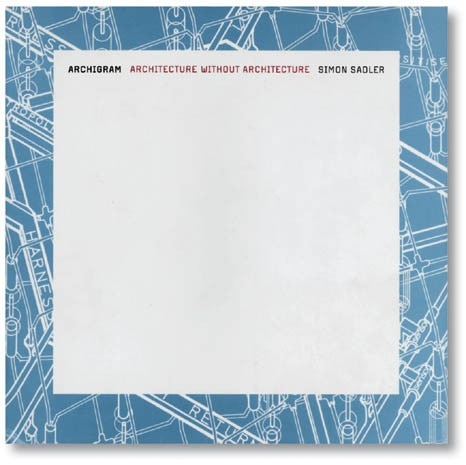Archigram, Architecture without architecture, Simon Sadler The MIT Press, Cambridge, Mass. – London, 2005 (pp. 242).
Archigram were the leading exponents of the experimental approach that appeared in architecture in the early 1960s. Declaring a strong wish for emancipation from previous legacies, this tended to develop in harmony with both the climate of linguistic renewal in the other creative disciplines and with the changes in culture and habits on the urban scene. The London group embraced the teachings and example of Cedric Price with regard to criteria of indefinite, perishable and multifunctional space, applying them to a new model of the city, with a type of design that theoretically accepted and laid claim - often ironically - to the characteristics of consumerism and standardisation. Their research seemed more innovative than the coeval experimentation that appeared almost simultaneously in Austria, initially with Hollein and Pichler, and shortly afterwards in Italy with Archizoom, Superstudio, Ufo and Pettena.
This innovation was thanks to the introduction of the new pop and super-graphic vernaculars into the traditional Modern language, and due to its intentional demystification of the project, which became a collage of colours and images, more a tool for thought communication than a moment of technological and functional information. Sadler’s monograph forms part of – and further enriches - the series of publications that have, over the last decade, revisited the experimental work of Archigram in detail, as occurred in Italy for Superstudio, Archizoom, Sottsass, Pettena, Mendini and, more generally, with the “Radicals” exhibition at the 1996 Venice Biennale.
This indicates fresh critical interest in the aspects that seem to have paved the way for contemporary operations in architecture that prove extra sensitive to the idea of the discipline’s relativity, its dependency on the rapid developments and changes in the city and the social set ups, and the constantly evolving media. From what is now a historic perspective, the author analyses in particular the “Living City” exhibition organised by the group in 1962 at the Institute of Contemporary Arts in London, to which he devotes a whole chapter. He claims and demonstrates that it proposed an idea of the city that was later destined to have major consequences: no longer merely the simple functional organisation of space but a vital support to constantly changing cultural mechanisms. With its fascination for the ephemeral and change, the exhibition introduced Archigram’s subsequent course and the influence it was to have on the “disappearance” of architecture in the years to come.
Archigram were the emblematic representatives of a generation and their research highlighted the need for new theoretical proposals, after the rigidities of Rationalism and the inadequacy of many of the Modern Movement’s propositions. They saw the “disappearance” of architecture as the logical consequence of excessive prior repression, an ironical response to the monumentalism manifested in a design based on interchangeable elements and industrial components, which delegated all the architect’s task and responsibilities to the user’s needs and imagination. The definition of architecture without architecture, or architecture without architects as Bernard Rudofsky provokingly entitled the exhibition he curated in 1964, echoed the beyond the object found in the art field in the very same years. It referred generically to a type of design, to experimental research, that embodied all the requisites of spatial, creative, political and consumer freedom that were surfacing in the social and cultural context of the 1960s.
In this context, Sadler’s essay pinpoints Archigram’s position as unique and anomalous within the sphere of “ideological disorder” prompted by this search for total freedom. Openly apolitical rather than politically engaged, more technocrats than anarchists, more individualists than hippies, as closely bound to the ideas of economic privilege of the 1950s as the egalitarian ones of the 1960s, according to Sadler they were the product of an elite culture that had steered them along the path of theoretical rather than operational research and was perpetuated in the academic sphere in the subsequent generations that came most directly under their influence.
This theory reveals a nostalgia for the slightly antiquated concept of architecture that always - almost as if to justify itself - finds the need for constructed examples if it is to be such. While it was, instead, Archigram – and later Hollein and Pichler, and above all the Italian “radicals” – that established the conviction that the re-founding of thought and languages, pure research, is both research and work, architecture. Even more so than their ideal referent Buckminster Fuller, the author argues that these “new prophets of architectural non-form” obtained, on the contrary, the result of creating a style.
Although they were inspired by an attitude of persistent optimism, trust and enthusiasm for all innovatory technology - with highly elaborate projects for living capsules and robotic cities ironically aimed at desecrating all the preconceptions of Functionalism or monumentalism – this was actually a forerunner and prelude to hi-tech architecture and the Deconstructivism of later decades. With their very personal style made of the advertising images, plastic, tubes and mechanical and electrical components with which they thought they could express themselves, and go beyond all conventionalism, the latent potential of the buildings and the city, they paradoxically based forms and styles on the instruments of the events of an evolving society.
What is new in Sadler’s book compared with the many other publications recently devoted to the London group is principally its study of their influence, analysed via concrete examples and precise reference to their work. The author’s theory is that Archigram were the initiators of mental and technical attitudes now common in those who design city spaces or construct with the aid of technology. This is not so much for what they constructed but because they helped to conceptually re-found the discipline, broadening it to cover every element that could help enrich it along a path of cultural evolution.
Gianni Pettena Professor of History of Architecture at Florence University


